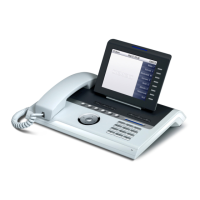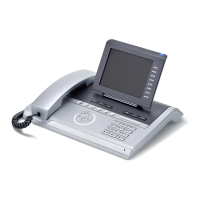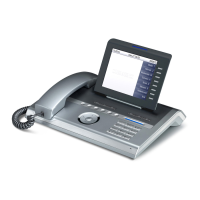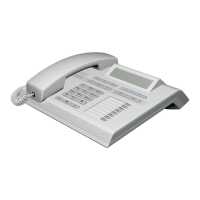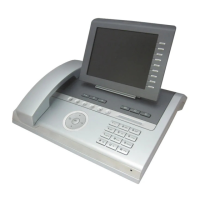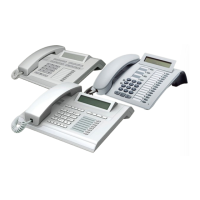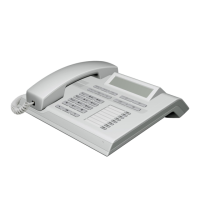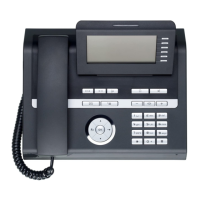Do you have a question about the Siemens OpenStage 40 HFA HiPath 4000 and is the answer not in the manual?
Compliance marks and trademark ownership details.
Guidelines for optimal placement and environmental conditions.
Instructions and precautions for updating the phone's software.
Overview of the manual's content and purpose.
Information on obtaining technical support and troubleshooting.
Specifies the authorized applications and functions of the phone.
Details on identifying the specific model and serial number.
Tips for optimizing audio performance and screen visibility.
Explains the multi-line capability and its implications.
Describes specialized features for executive-secretary setups.
Identifies and explains the main operating elements of the phone.
Details the physical connections and interfaces available on the phone.
Information on adding optional key modules to expand phone functionality.
Explains the phone's key layout and functions.
Explains the purpose and operation of dedicated function keys.
Describes keys used for adjusting audio settings and features.
Details how to use the navigation control for phone functions.
Guide to customizing and assigning functions to sensor keys.
Instructions on using the keypad for dialing and text input.
Explains the use of keys for special input and control functions.
Describes the phone's LCD screen and its various display modes.
Details the phone's state when not in an active call.
Explains how to access and navigate the phone's main menu.
Provides a reference for understanding icons displayed on the phone.
Describes the visual information and functions shown on the display during calls.
Explains how the display reflects activity across multiple phone lines.
Reference guide for icons indicating the status of calls.
Information on accessing voice and fax messages and callbacks.
How to request and manage callbacks when a party is busy or unavailable.
Details on viewing and managing lists of unanswered, incoming, and outgoing calls.
Instructions for accessing and using the phone's service and configuration menu.
Steps for answering incoming calls using the handset or speakerphone.
Procedures for switching between handset and speakerphone during a call.
How to return to using the handset after speakerphone mode.
Enabling others in the room to hear the call via the loudspeaker.
Methods for terminating an active call on the phone.
Making calls by lifting the handset before dialing.
Making calls using speakerphone or the handset without lifting it.
Using direct station selection keys to initiate calls.
How to redial numbers previously saved for quick access.
Procedures for redialing the most recently dialed number.
Muting and unmuting the microphone during a call.
How to place a call to a second person while holding the first call.
Procedures for switching between the primary and secondary calls.
Steps to merge two separate calls into a conference call.
How to redirect a call to another extension or person.
A summary of different call forwarding options available.
How to set up unconditional call forwarding to a specific destination.
Setting up call forwarding that is deleted upon deactivation.
Configuration for forwarding calls based on busy or no-reply conditions.
How call forwarding status is indicated on the phone's display.
How to request a callback when a party is busy or unavailable.
Managing previously stored callback requests.
Saving numbers for quick redialing via line keys.
Answering calls using a headset or a direct station selection key.
Picking up calls intended for colleagues within a team.
How to answer a call directed to a specific extension.
Answering calls routed to a hunt group.
Making and receiving calls using the phone's built-in speaker.
Initiating calls using pre-programmed speed dial or DSS keys.
Making calls by selecting numbers from call logs or other lists.
Procedures for making calls using saved speed dial numbers.
Placing and receiving one-way speaker calls to colleagues.
Handling incoming calls while already on a call using DSS keys.
Managing multiple incoming calls and switching between them.
Answering a waiting call using a programmed sensor key.
Answering a waiting call through the phone's menu system.
Explains the functionality of a programmed shift key for extended operations.
Details on setting up and managing multi-party conference calls.
Step-by-step guide to initiating conference calls from various states.
How to include additional participants in an ongoing conference call.
Bringing an incoming call into an active conference call.
Procedures for transferring an entire conference to another party.
How to remove an individual from a conference call.
Temporarily suspending a conference call to handle other lines.
Using DTMF tones for controlling external devices or systems.
Holding calls in a system-wide queue for retrieval on another phone.
How to alert a busy party that you are waiting to connect.
Procedures for connecting to a busy line when authorized.
Using the phone as an intercom for internal communication.
Placing one-way speaker calls to any internal party.
Initiating speaker calls to members of a defined group.
Establishing a two-way intercom conversation with a variable destination.
Establishing a two-way intercom conversation with a pre-programmed destination.
Sending announcements to all members of a designated line group.
Overview and configuration of various call forwarding settings.
Setting up call forwarding for external phones, fax, or PC stations.
Configuring call forwarding for specific station types like fax or busy.
Checking and disabling call forwarding settings for other phones.
Managing call forwarding for fax, PC, or busy station types.
Modifying existing call forwarding configurations for other stations.
Managing membership in a hunt group.
Assigning specific phone functions or numbers to sensor keys.
Setting up keys for speed dialing or direct station selection.
Exploring advanced features for repdial keys, like pauses.
Customizing the text labels displayed on sensor keys.
Information about system-wide speed dial directories.
Saving speed dial numbers that include sequences or extensions.
Programming personal speed dial numbers for quick access.
Setting up reminders for appointments via phone calls.
How timed reminders are delivered and managed.
Assigning external calls to specific projects using account codes.
How the phone displays call duration or charges.
Securing the phone by locking it with a PIN.
Enabling or disabling the DND feature to block incoming calls.
Blocking or allowing speaker calls to the phone.
Hiding the caller's number for specific outgoing calls.
Procedures for tracing unidentified callers.
Logging into other phones using personal credentials.
How to log out from remote phone sessions.
Explains the use of sensor keys as line selectors for multi-line phones.
Describes the main line used for incoming and outgoing calls.
Information on how secondary lines function within the system.
Explains different types of line usage: private, shared, and direct.
How to preview incoming call information on other lines.
Methods for answering calls using specific line keys.
Controlling ring notifications for incoming calls on specific lines.
Initiating calls using the phone's line keys.
Redialing saved numbers on specific phone lines.
Redialing the last number called on a particular line.
Saving numbers for redialing on specific lines.
Accessing voicemail messages left for specific lines.
Procedures for retrieving messages from the line mailbox.
Determining which line is currently active or in use.
Managing and switching between calls on different lines.
How to disconnect a call associated with a specific line key.
Establishing a three-party conference call on a single line.
Controlling who can join an active call on a line.
Preventing other parties from joining an ongoing call.
Allowing a designated party to silently monitor a call.
Placing calls on hold and resuming them using line keys.
Holding calls exclusively for personal access.
Taking over a call that a colleague has placed on hold.
Activating call forwarding for specific lines.
Transferring incoming calls to another destination, bypassing local ringing.
How secretaries and executives can call each other's phones.
Procedures for answering executive calls from a secretary's phone.
Handling a new executive call while already engaged in another call.
Redirecting calls directly to the executive's phone from the secretary's.
Methods for transferring calls to the executive's line.
How executives receive calls directed to their phone.
Picking up calls for other executive-secretary pairs.
Utilizing a secondary phone for executive call management.
Managing incoming calls when the executive is already on a call.
Sending a brief signal to another phone to get attention.
Initiating a call to leave a message for someone.
Setting up alternative call handling for the secretary's phone.
Adjusting the phone's screen angle, illumination, and contrast.
Fine-tuning screen contrast for better readability.
Adjusting contrast for connected key modules.
Optimizing ring volume, tone, and speakerphone room character.
Adjusting the volume for alert tones, like second call notifications.
Adjusting the volume for rollover notifications.
Enabling or disabling the phone's ringing function.
Performing checks on phone components like keys, display, and audio.
Explains features related to the "One Number Service" group functionality.
Troubleshooting common error messages displayed on the phone.
Guidance on when and whom to contact for persistent issues.
General advice for resolving common phone malfunctions.
Recommendations for cleaning and maintaining the telephone.
Compliance marks and trademark ownership details.
Guidelines for optimal placement and environmental conditions.
Instructions and precautions for updating the phone's software.
Overview of the manual's content and purpose.
Information on obtaining technical support and troubleshooting.
Specifies the authorized applications and functions of the phone.
Details on identifying the specific model and serial number.
Tips for optimizing audio performance and screen visibility.
Explains the multi-line capability and its implications.
Describes specialized features for executive-secretary setups.
Identifies and explains the main operating elements of the phone.
Details the physical connections and interfaces available on the phone.
Information on adding optional key modules to expand phone functionality.
Explains the phone's key layout and functions.
Explains the purpose and operation of dedicated function keys.
Describes keys used for adjusting audio settings and features.
Details how to use the navigation control for phone functions.
Guide to customizing and assigning functions to sensor keys.
Instructions on using the keypad for dialing and text input.
Explains the use of keys for special input and control functions.
Describes the phone's LCD screen and its various display modes.
Details the phone's state when not in an active call.
Explains how to access and navigate the phone's main menu.
Provides a reference for understanding icons displayed on the phone.
Describes the visual information and functions shown on the display during calls.
Explains how the display reflects activity across multiple phone lines.
Reference guide for icons indicating the status of calls.
Information on accessing voice and fax messages and callbacks.
How to request and manage callbacks when a party is busy or unavailable.
Details on viewing and managing lists of unanswered, incoming, and outgoing calls.
Instructions for accessing and using the phone's service and configuration menu.
Steps for answering incoming calls using the handset or speakerphone.
Procedures for switching between handset and speakerphone during a call.
How to return to using the handset after speakerphone mode.
Enabling others in the room to hear the call via the loudspeaker.
Methods for terminating an active call on the phone.
Making calls by lifting the handset before dialing.
Making calls using speakerphone or the handset without lifting it.
Using direct station selection keys to initiate calls.
How to redial numbers previously saved for quick access.
Procedures for redialing the most recently dialed number.
Muting and unmuting the microphone during a call.
How to place a call to a second person while holding the first call.
Procedures for switching between the primary and secondary calls.
Steps to merge two separate calls into a conference call.
How to redirect a call to another extension or person.
A summary of different call forwarding options available.
How to set up unconditional call forwarding to a specific destination.
Setting up call forwarding that is deleted upon deactivation.
Configuration for forwarding calls based on busy or no-reply conditions.
How call forwarding status is indicated on the phone's display.
How to request a callback when a party is busy or unavailable.
Managing previously stored callback requests.
Saving numbers for quick redialing via line keys.
Answering calls using a headset or a direct station selection key.
Picking up calls intended for colleagues within a team.
How to answer a call directed to a specific extension.
Answering calls routed to a hunt group.
Making and receiving calls using the phone's built-in speaker.
Initiating calls using pre-programmed speed dial or DSS keys.
Making calls by selecting numbers from call logs or other lists.
Procedures for making calls using saved speed dial numbers.
Placing and receiving one-way speaker calls to colleagues.
Handling incoming calls while already on a call using DSS keys.
Managing multiple incoming calls and switching between them.
Answering a waiting call using a programmed sensor key.
Answering a waiting call through the phone's menu system.
Explains the functionality of a programmed shift key for extended operations.
Details on setting up and managing multi-party conference calls.
Step-by-step guide to initiating conference calls from various states.
How to include additional participants in an ongoing conference call.
Bringing an incoming call into an active conference call.
Procedures for transferring an entire conference to another party.
How to remove an individual from a conference call.
Temporarily suspending a conference call to handle other lines.
Using DTMF tones for controlling external devices or systems.
Holding calls in a system-wide queue for retrieval on another phone.
How to alert a busy party that you are waiting to connect.
Procedures for connecting to a busy line when authorized.
Using the phone as an intercom for internal communication.
Placing one-way speaker calls to any internal party.
Initiating speaker calls to members of a defined group.
Establishing a two-way intercom conversation with a variable destination.
Establishing a two-way intercom conversation with a pre-programmed destination.
Sending announcements to all members of a designated line group.
Overview and configuration of various call forwarding settings.
Setting up call forwarding for external phones, fax, or PC stations.
Configuring call forwarding for specific station types like fax or busy.
Checking and disabling call forwarding settings for other phones.
Managing call forwarding for fax, PC, or busy station types.
Modifying existing call forwarding configurations for other stations.
Managing membership in a hunt group.
Assigning specific phone functions or numbers to sensor keys.
Setting up keys for speed dialing or direct station selection.
Exploring advanced features for repdial keys, like pauses.
Customizing the text labels displayed on sensor keys.
Information about system-wide speed dial directories.
Saving speed dial numbers that include sequences or extensions.
Programming personal speed dial numbers for quick access.
Setting up reminders for appointments via phone calls.
How timed reminders are delivered and managed.
Assigning external calls to specific projects using account codes.
How the phone displays call duration or charges.
Securing the phone by locking it with a PIN.
Enabling or disabling the DND feature to block incoming calls.
Blocking or allowing speaker calls to the phone.
Hiding the caller's number for specific outgoing calls.
Procedures for tracing unidentified callers.
Logging into other phones using personal credentials.
How to log out from remote phone sessions.
Explains the use of sensor keys as line selectors for multi-line phones.
Describes the main line used for incoming and outgoing calls.
Information on how secondary lines function within the system.
Explains different types of line usage: private, shared, and direct.
How to preview incoming call information on other lines.
Methods for answering calls using specific line keys.
Controlling ring notifications for incoming calls on specific lines.
Initiating calls using the phone's line keys.
Redialing saved numbers on specific phone lines.
Redialing the last number called on a particular line.
Saving numbers for redialing on specific lines.
Accessing voicemail messages left for specific lines.
Procedures for retrieving messages from the line mailbox.
Determining which line is currently active or in use.
Managing and switching between calls on different lines.
How to disconnect a call associated with a specific line key.
Establishing a three-party conference call on a single line.
Controlling who can join an active call on a line.
Preventing other parties from joining an ongoing call.
Allowing a designated party to silently monitor a call.
Placing calls on hold and resuming them using line keys.
Holding calls exclusively for personal access.
Taking over a call that a colleague has placed on hold.
Activating call forwarding for specific lines.
Transferring incoming calls to another destination, bypassing local ringing.
How secretaries and executives can call each other's phones.
Procedures for answering executive calls from a secretary's phone.
Handling a new executive call while already engaged in another call.
Redirecting calls directly to the executive's phone from the secretary's.
Methods for transferring calls to the executive's line.
How executives receive calls directed to their phone.
Picking up calls for other executive-secretary pairs.
Utilizing a secondary phone for executive call management.
Managing incoming calls when the executive is already on a call.
Sending a brief signal to another phone to get attention.
Initiating a call to leave a message for someone.
Setting up alternative call handling for the secretary's phone.
Adjusting the phone's screen angle, illumination, and contrast.
Fine-tuning screen contrast for better readability.
Adjusting contrast for connected key modules.
Optimizing ring volume, tone, and speakerphone room character.
Adjusting the volume for alert tones, like second call notifications.
Adjusting the volume for rollover notifications.
Enabling or disabling the phone's ringing function.
Performing checks on phone components like keys, display, and audio.
Explains features related to the "One Number Service" group functionality.
Troubleshooting common error messages displayed on the phone.
Guidance on when and whom to contact for persistent issues.
General advice for resolving common phone malfunctions.
Recommendations for cleaning and maintaining the telephone.
